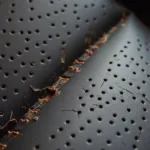Maintaining a car’s interior, especially the seats, is crucial for its overall appeal and value. But accidents happen, and upholstery can tear, fade, or stain over time. While it might seem daunting, repairing car seat upholstery is often achievable without professional help. This guide will explore the steps involved in effectively repairing common car seat upholstery issues, helping you restore your car’s interior to its former glory.
Identifying the Upholstery Material
Before diving into repairs, knowing the type of material is key. Car upholstery typically falls into two categories:
- Fabric: This includes various materials like cloth, velour, or vinyl. Fabric upholstery is generally budget-friendly and offers a comfortable feel.
- Leather: Known for its luxurious look and feel, leather car upholstery is more expensive and demands specific cleaning and conditioning methods.
The repair process differs slightly based on the material, so identifying it correctly is vital for choosing the right tools and techniques.
Common Car Seat Upholstery Issues and DIY Fixes
Tears and Burns
Small tears and burns are common car upholstery woes, often caused by sharp objects or careless cigarette handling. For minor tears in fabric upholstery, a fabric repair kit can work wonders. These kits typically include a bonding agent and fabric patches that you can color-match to your upholstery.
Here’s a step-by-step guide on using a fabric car seat repair kit:
- Clean the area: Gently clean the torn area with a mild cleaner and a soft cloth to remove dirt and debris. Allow it to dry thoroughly.
- Apply the bonding agent: Apply a thin layer of the bonding agent to the back of the tear. If your kit includes a backing patch, adhere it to the bonding agent.
- Position the fabric patch: Carefully align the fabric patch over the tear, ensuring it covers the entire damaged area and blends seamlessly with the surrounding fabric.
- Apply pressure: Firmly press down on the patch for the amount of time specified in the kit’s instructions. This will ensure a strong bond between the patch and the upholstery.
- Trim any excess: If the patch extends beyond the tear, carefully trim it with small scissors for a clean and professional-looking finish.
For leather upholstery, repairing tears often requires professional intervention, especially if the tear is large or located in a high-stress area. However, you can use a how to repair leather car seats seams technique to fix minor tears along the seams using a leather repair kit and adhesive.
Stains and Spills
Stains are an inevitable part of life, and car seats are prone to spills and blemishes. The key to effective stain removal is to act fast. Blot the spill immediately with a clean cloth to prevent it from setting. Avoid rubbing, as it can push the stain deeper into the fabric.
Here are some common stain removal techniques:
- Fabric Upholstery: For fabric car seats, a mixture of warm water and mild laundry detergent usually does the trick. Apply the solution to a clean cloth and gently blot the stain. For stubborn stains, consider using a specialized upholstery cleaner.
- Leather Upholstery: Leather requires a gentler approach. Use a pH-neutral leather cleaner and a soft cloth to blot the stain. Avoid harsh chemicals, as they can damage the leather’s finish.
Fading and Discoloration
Prolonged exposure to sunlight can cause car seat upholstery to fade and lose its vibrancy. Using a sunshade when parking your car can help prevent this. For already faded upholstery, consider using a fabric or leather dye specifically designed for automotive use. Always test the dye on an inconspicuous area first to ensure color matching and avoid unwanted results.
Wear and Thinning
Over time, car seats can show signs of wear and tear, with fabric thinning or leather developing cracks. While minor wear is expected, addressing it promptly can prevent further damage. For fabric seats, consider using seat covers to protect the original upholstery. Leather seats benefit from regular cleaning and conditioning to keep the material supple and prevent cracking.
When to Seek Professional Help
While DIY repairs can address many common car seat upholstery issues, some situations warrant professional intervention:
- Extensive damage: Large tears, burns, or deep scratches often require specialized tools and expertise that are best left to professionals.
- Airbag deployment: If your car has been in an accident where the airbags deployed, it’s crucial to have the entire seat system inspected and repaired by a qualified technician.
- Structural damage: Any damage to the seat’s frame or internal components requires immediate attention from a professional to ensure safety and proper functioning.
Expert Insights
“Preventing upholstery damage is always easier than repairing it,” advises John Miller, a seasoned automotive upholsterer with over 20 years of experience. “Regular cleaning, using protective covers, and addressing spills promptly can significantly extend the lifespan of your car seats.” He further emphasizes, “When in doubt, consult a professional. Attempting complex repairs without proper knowledge and tools can worsen the damage.”
Conclusion
Maintaining your car’s interior, especially the upholstery, is a worthwhile endeavor. By promptly addressing minor issues and knowing when to seek professional help, you can keep your car looking its best for years to come. Remember, a well-maintained interior not only enhances your driving experience but also contributes to the vehicle’s resale value.
FAQs about Car Seat Upholstery Repair
Q: Can I use super glue to fix a tear in my leather car seat?
A: While super glue might seem like a quick fix, it’s not recommended for leather car seats. It can create a stiff, unsightly bond that can crack over time. Instead, opt for a leather repair kit or seek professional help.
Q: How often should I condition my leather car seats?
A: It’s generally recommended to condition your leather car seats every three to six months, depending on usage and climate. Regular conditioning helps keep the leather soft, supple, and resistant to cracking.
Q: Can I dye my faded fabric car seats a different color?
A: Yes, you can dye faded fabric car seats a different color using fabric dye designed for automotive use. However, achieving a uniform and professional-looking result can be challenging, and it’s generally recommended for experienced DIYers.
Q: Is it worth repairing a small cigarette burn on my car seat?
A: Yes, repairing a small cigarette burn is usually worthwhile, as it can prevent the damage from worsening and maintain the car’s value. You can often address minor burns using a fabric repair kit or by seeking professional help.
Q: What’s the best way to clean pet hair from car upholstery?
A: A lint roller, rubber gloves, or a vacuum cleaner with a upholstery attachment can effectively remove pet hair from car upholstery. For embedded hair, consider using a specialized pet hair removal tool.
Looking for more information on specific car seat upholstery repair topics?
- Check out our comprehensive guide on how to repair perforated leather car seats.
- Learn how much to repair a torn leather car seat and explore cost-effective solutions.
- Discover the essential tools and techniques for using a car seat repair kit fabric effectively.
We’re here to help you keep your car’s interior looking its best! For personalized advice or assistance with challenging repairs, reach out to our team of experts via WhatsApp at +1(641)206-8880 or email us at [email protected]. We offer 24/7 support to answer your queries and provide tailored solutions.



